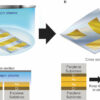A study, published in PNAS Nexus, describes a fabric that can be modulated between two different states to stabilize radiative heat loss and keep the wearer comfortable across a range of temperatures.
Po-Chun Hsu, Jie Yin, and colleagues designed a fabric made of a layered semi-solid electrochemical cell deployed on nylon cut in a kirigami pattern to allow it to stretch and move with the wearer’s body. Modern clothes are made with a variety of insulating or breathable fabrics, but each fabric offers only one thermal mode, determined by the fabric’s emissivity: the rate at which it emits thermal energy.
The active material in the fabric can be electrically switched between two states—a transmissive dielectric state and a lossy metallic state—each with different emissivity. The fabric can thus keep the wearer comfortable by adjusting how much body heat is retained and how much is radiated away. A user would feel the same skin temperature whether the external temperature was 22.0°C (71.6°F) or 17.1°C (62.8°F). The authors call this fabric a “wearable variable-emittance device,” or WeaVE, and have configured it to be controlled with a smartphone app.
Some active thermoregulatory fabrics use technologies such as electric heating or recirculating water, but they are energy intensive. The only energy required by the WeaVE system is the small amount of energy required to switch the fabric’s state. The authors estimate the fabric could be switched approximately 1,000 times with the energy stored in a typical smartphone battery.
More information:
Po-Chun Hsu, A Kirigami-enabled Electrochromic Wearable Variable Emittance (WeaVE) Device for Energy-Efficient Adaptive Personal Thermoregulation, PNAS Nexus (2023). DOI: 10.1093/pnasnexus/pgad165
Provided by
PNAS Nexus
Citation:
Researchers design a fabric that actively regulates temperature with the flip of a switch (2023, June 14)



